| Daughters of the Revolution (D.O.R.)--The Anna B.
Johnson monument (1926) stone contains a dove with seven stars above it and a ribbon with
the letters D.O.R underneath. This is the symbol of the Daughters of the Revolution. The
stone is located in block I in the Original Section. |
|

|
Anna B Johnson |
|
Dove--The dove is a symbol of peace. In a religious setting, it may
also be an image of purity, the soul, or the Holy Spirit. [10] There are examples from
both the nineteenth and twentieth centuries, but it is more common on nineteenth century
markers. The Luella Overman monument in block C of the Original Section is a nineteenth
century example. A twentieth century example of a dove can be found in block 3 of the
Sunnydale Addition.
|
|

|

|
Luella Overman |
Dove |
|
Flame--A flame represents life, and on a grave marker it is often
seen as an eternal flame, a symbol for eternal life. [11] The Art-Deco Holst family
monument, dating from the 1960s, is Greenwood’s best example. It can be found in the
block E of the Original Section at the Y in the road.
|
|

|
Art-Deco Holst |
|
Fleur-de-lys--The fleur-de-lys is a symbol of the Holy Trinity, the
Father, Son, and Holy Spirit. In a Catholic Cemetery, it can also be a symbol of the
Virgin Mary because it is derived from the lily. The lily, which represents virginity and
purity, is associated with Mary. [12] The Chapman monument, found in block C of the
Original Section, is adorned with fleur-de-lys.
|
|
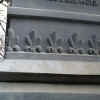
|
Fleur-de-lys |
|
| Hands--Hands are one of the most common symbols found at Greenwood
on both nineteenth and twentieth century markers. They are one of two most common symbols
on eighteenth and nineteenth century Protestant tombstones. [13] There is a significant
number of 20th century stones at Greenwood depicting hands, but not as many as on
nineteenth century stones. Hands have several meanings. A single hand either pointing up
or down may represent the hand of God. A hand pointing up may also be the hand of the
deceased pointing up to their heavenly reward. [14] An example of this design in Greenwood
is the stone of G. Ford (nineteenth century), located in Block F of the Original Section.
The Henry A. Cole stone, in block G of the Original Section, depicts a hand reaching for a
crown, the crown of righteousness (see Crown, above). A hand touching a book, as found on
the Griffith stone (1869) in block G of the Original Section, indicates that the Word of
God is the way to salvation (see Book, above). Two hands clasped indicate a close
relationship, usually marriage. [15] The Calvin Ford stone (nineteenth century), located
next to the G. Ford monument in block F of the Original Section, is an excellent
example of this common design. Twentieth century stones with this design, such as one in
block 1 of the Sunny Slope Addition, usually have the couple’s wedding date engraved
beneath the design. A particularly interesting design can be found on the stone of Amanda
Curtis (1925) in block J of the Original Section. It contains a hand reaching down and
holding a chain by one finger. It most likely represents the end of life and God’s
hand or role in the end (see Anchor, above). On more recent stones, the famous
"Praying Hands" by German artist Albrecht Durer is found. [16] One example is
located in block G of the Woodlawn addition.
|
|
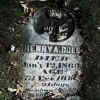
|
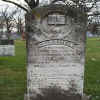
|
Cole |
Griffin |
| |
|
|

|
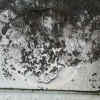
|
Clasped Hands |
Chain |
| |
|
|
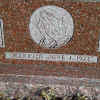
|
Praying Hands |
|
| IHS--The first three letters in the Greek spelling of Jesus are
IHS. In the Middle Ages this was incorrectly interpreted as "Jesus Hominum
Salvatore" or "Jesus Savior of Mankind". [17] This interpretation has
stuck, and the letters have thus acquired a greater significance than originally
understood. The Thomas Pryor cross (late nineteenth or early twentieth century) is an
example of this usage. It can be found in block K of the Original Section. |
|
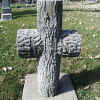
|
Rustic Cross |
|
| Lamb--The lamb is a symbol of innocence and purity. It may also be
interpreted to represent Christ as the "Lamb of God". [18] It is usually found
on the markers of children. Several examples can be found on the north edge of the St.
Bernard Addition. An adult stone containing a lamb is that of Hans Slifsgard (1871),
located in block G of the Original Section. |
|

|
Lambcem |
|
Lamp--The lamp is a symbol of knowledge or eternal life. [19] An
example can be found on the Brookins-Moore monument (early twentieth century) in block B
of the Original Section.
|
|
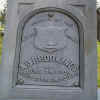
|
Lamp |
|
Orb--An orb, in this case, is a large sphere
topping a gravestone. It represents a celestial body and the reward of resurrection.[20]
An example is Humbert stone (1860's or 70's) in block D of the Original Section near the
middle.
|
|

|
Orb |
|